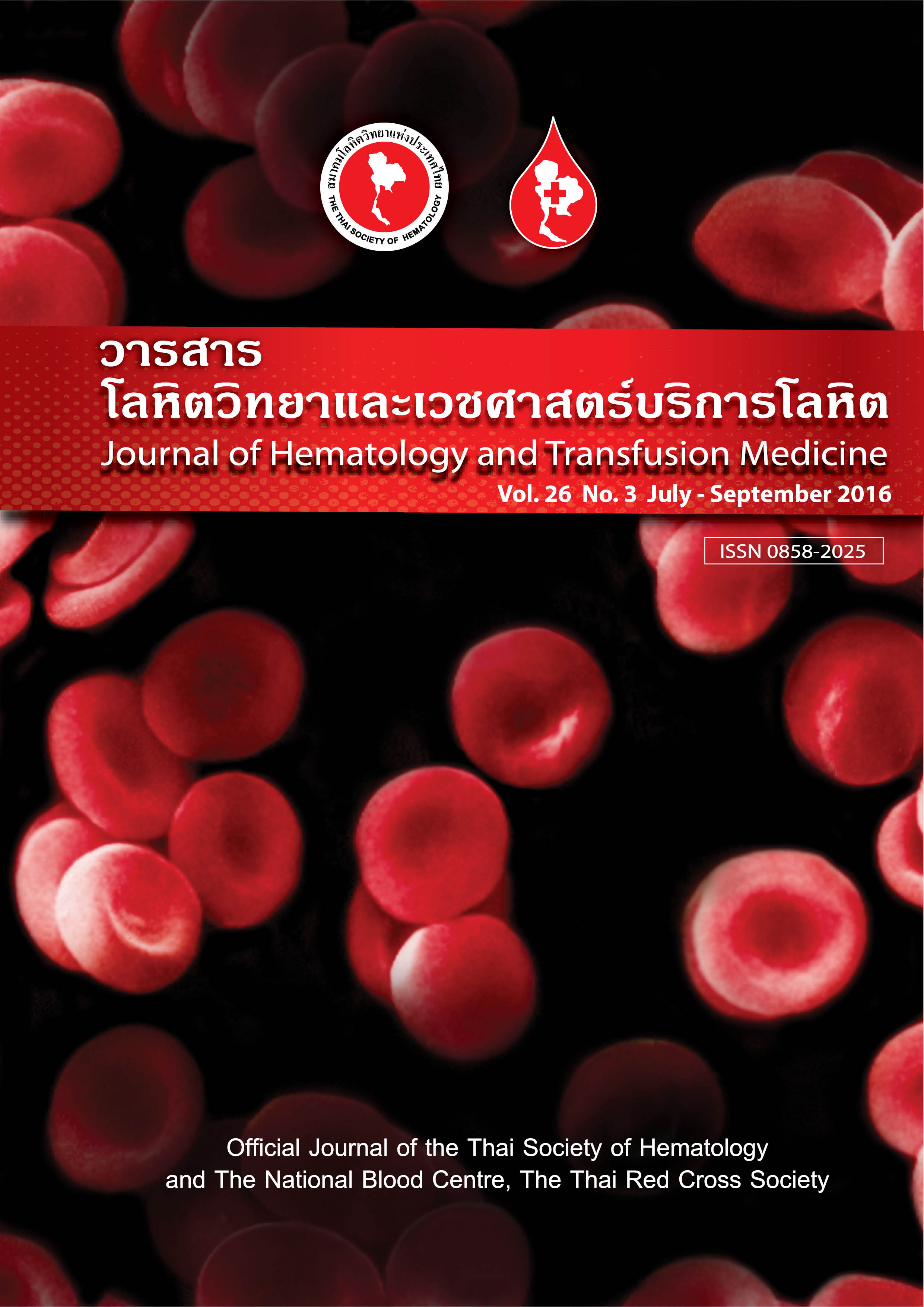Relationship between Serum Ferritin Level and Left Ventricular Function in Thalassemia Patients
Keywords:
Echocardiography, Left ventricular ejection fraction, Serum ferritin, ThalassemiaAbstract
Abstract:
Objective: The study aim was to investigate the relationship between serum ferritin levels and left ventrivular ejection fraction (LVEF) among thalassemia patients. Materials and Methods: Adult thalassemia patients at Panyananthaphikkhu Chonprathan Medical Center and Faculty of Medicine Vajira Hospital from May 6, 2014 to October 26, 2015 were enrolled. Clinical parameters and outcome data were extracted from medical records. Two-dimensional (2D) echocardiography and serum ferritin were performed within 2 weeks. If the echocardiography result showed structural heart disease, we excluded the patient from this study. Results: Thirty-five thalassemia patients were examined (female 21 and male 14). Twenty were transfusion dependent thalassemia (TDT), while 15 were nontransfusion dependent thalassemia (NTDT). Mean age was 41.5 years old. History of blood transfusion was 85.7%. Mean amount of blood transfusion was 22 units. The mean hematocrit was 22.87%. The median serum ferritin level was 1,201 ng/mL. Median serum ferritin level among males was higher than among females, but the difference was insignificant. The mean ejection fraction was 65%. Serum ferritin levels showed a weak negative correlation with the LVEF. Conclusion: Our results revealed serum ferritin levels showed a negative correlation with the left ventricular ejection fraction.
บทคัดย่อ
วัตถุประสงค์ เพื่อศึกษาความสัมพันธ์ระหว่างค่า serum ferritin และ left ventricular ejection fraction (LVEF) ในผู้ป่วยธาลัส-ซีเมียในปริมาณที่แตกต่างกันมีผลต่อการทำงานของหัวใจ วัสดุและวิธีการ ผู้ป่วยธาลัสซีเมียอายุมากกว่า 18 ปีขึ้นไป ตั้งแต่ 6 พฤษภาคม พ.ศ. 2557 ถึง 26 ตุลาคม พ.ศ. 2558 โดยเก็บข้อมูลพื้นฐานทางคลินิกข้อมูลพื้นฐานทางห้องปฏิบัติการการรักษารวมถึงผล ferritin และผลการตรวจหัวใจด้วยคลื่นความถี่สูงในระยะเวลาห่างกันไม่เกิน 2 สัปดาห์ หากผลการตรวจหัวใจด้วยคลื่นความถี่สูงมีความผิดปกติจากโรคหัวใจแต่กำเนิด จะตัดผู้ป่วยรายนั้นออกจากการศึกษา ผลการวิจัย มีผู้ป่วยธาลัสซีเมียในการศึกษาทั้งหมด 35 ราย (หญิง 21 ราย ชาย 14 ราย) โดยมีชนิดพึ่งพาเลือด 20 รายและชนิดไม่พึ่งพาเลือด 15 รายค่าเฉลี่ยของอายุเท่ากับ 41.49 ปี ผู้ป่วยมีประวัติรับเลือดร้อยละ 85.7 ค่าเฉลี่ยจำนวนเลือดแดงที่ใช้เท่ากับ 22 ยูนิต ผล Hematocrit เฉลี่ยเท่ากับร้อยละ 22.87 ค่ามัธยฐาน serum ferritin เท่ากับ 1,201 ng/mL ค่ามัธยฐาน serum ferritin ในเพศชายสูงกว่าเพศหญิงเล็กน้อยแต่ไม่มีความแตกต่างกันทางนัยสถิติค่ามัธยฐานของ LVEF เท่ากับร้อยละ 65 serum ferritin มีความสัมพันธ์เชิงผกผันกับ LVEF อย่างไม่มีนัยสำคัญทางสถิติ สรุป Serum ferritin ที่สูงขึ้นมีความสัมพันธ์กับ LVEF ที่ต่ำลงในผู้ป่วยธาลัสซีเมียอย่างไม่มีนัยสำคัญทางสถิติ



